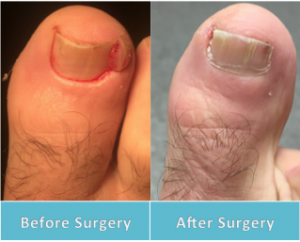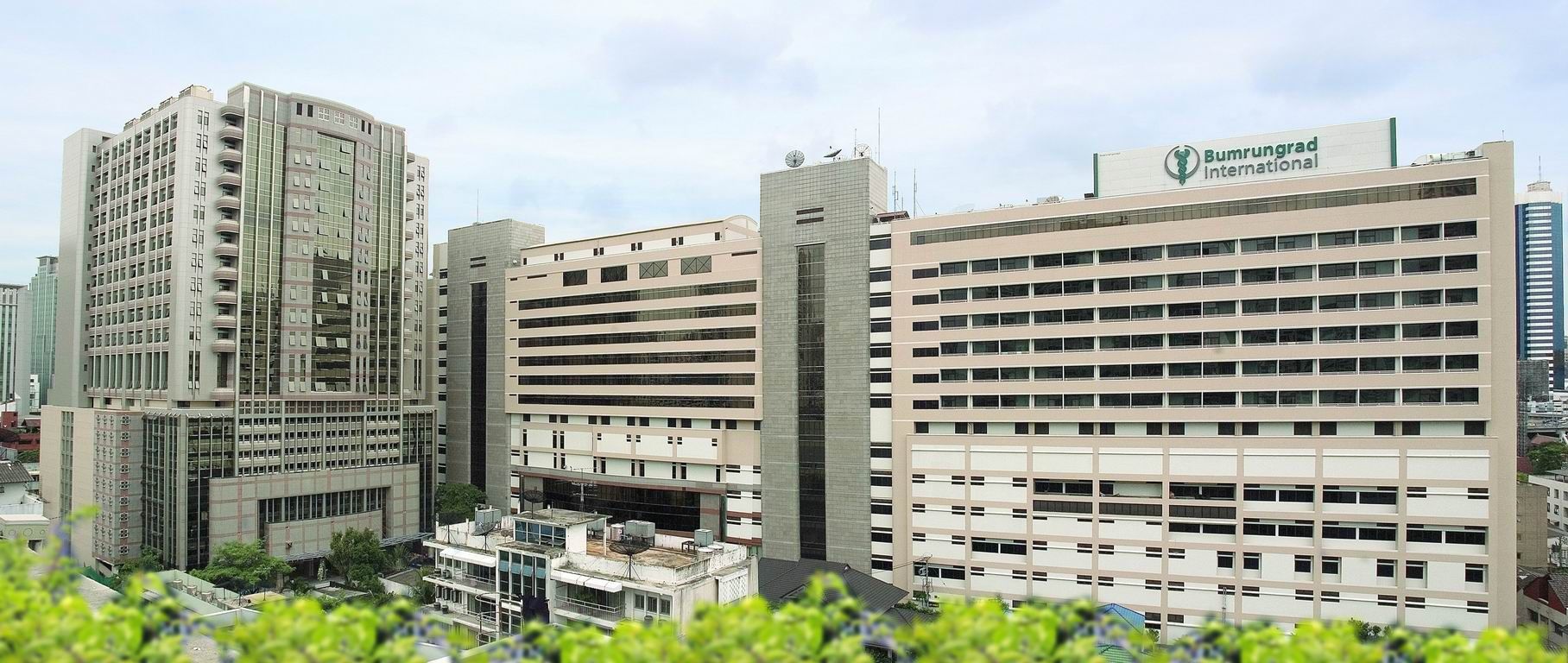General Surgery
Surgery for Ingrown Toenail Treatment
Ingrown Toenail Surgery
An ingrown toenail generally occurs when the top corner or side of an individual’s toenail grows into the flesh next to it. It happens usually on their big toe.
What are Ingrown Toenails?
An ingrown toenail generally occurs when the top corner or side of an individual’s toenail grows into the flesh next to it. It happens usually on their big toe.
Some of the common causes of ingrown toenails may include the following:
- Wearing shoes that are maybe too tight around their toe
- Cutting the toenails too short or with too much of a curve
- Toenail or toe injury
- Toenail naturally grows into a curve

Many of the ingrown toenails can be successfully treated with the help of the homemade remedies. But if an individual has any complications, such as a skin infection, or if they get a lot of ingrown toenails, surgery may be useful for preventing these complications. People, who are having diabetes or have any other conditions that affect their foot, are more likely to require undergoing the surgery.
Need for Ingrown Toenail Treatment
Surgical procedures for treating ingrown toenails are done when other medical approaches are not effective or when the ingrown nail continually hurts, infected, or has other issues. Here’s a detailed look at the circumstances and procedure:
- Recurrent Issues
- Infection
- Severe Pain
- Underlying Conditions
- Failure of Conservative Treatments
Symptoms of ingrown toenails
Common symptoms of ingrown toenails may include the following:
- Pain caused around the toenail edges
- Building up of fluid and thickening in the skin around the toenail
- Swelling and redness around the toenail
- Infection with draining pus around an individual’s toenail
Risks of Ingrown Toenail Removal
Ingrown toenail surgery is in most part safe, however it, like every other surgery poses certain risks and side effects. Here are the key risks associated with ingrown toenail surgery:
- Infection
- Recurrence of Ingrown Toenail
- Pain and Discomfort
- Bleeding
- Nerve Damage
- Scarring
- Nail Deformity
- Blood Clots
- Allergic Reactions to Anaesthesia
- Delayed Healing
What are causes that can cause an ingrown toenail?
Many things can result in ingrown toenails. One of the main causes is wearing shoes that do not fit properly. Shoes that are maybe are too tight or too small and thus this can result in pressing of their toenail in an unnatural way. Improper trimmed toenails are another main reason. Toenails that are peeled off at the edge or trimmed down at the corners have more chances of becoming ingrown. An injury to toe can also result in an ingrown toenail. People who have misshaped or deformed toenails have higher chances of having ingrown toenails.
The doctor may suggest ingrown toenail surgery if:
- The home remedies don’t resolve the patient’s ingrown toenail problem
- The patients have recurring ingrown toenails problem
- The patients have another condition such as diabetes that makes complications more favorable
- Part of the patient’s toenail or the full toenail may be required to be removed, depending on the situation.
Facilities and Services offered for International Patients for Ingrown Toenail Removal
In case of an international patient with an ingrown toenail, many medical facilities make an effort to provide a specialization for such services to ensure an easy procedure. Such services mostly emphasize that the patient has all the necessary care, support from a logistical standpoint, and all the information. Here are some of the key facilities and services commonly offered for international patients seeking ingrown toenail treatment:
- Consultation and Diagnosis
- Medical Treatment
- Language Support Services
- Travel Assistance
- Cost Transparency
- Coordination of Post-Treatment Care
- Personalized Support
- Medical Records and Reports
- Extended Stay and Recovery Facilities
Pre-Treatment Process of Ingrown Toenail Surgery
The preparation procedure before the direct ingrown toenail surgery is an important prerequisite to a successful outcome of the surgery and readiness of the patient. Below are the key steps involved in the pre-treatment process:
- Initial Consultation
- Treatment Plan Discussion
- Preparation for Surgery
- Preparing for Post-Surgery Care
- Mental and Emotional Preparation
Diagnostic Tests for Ingrown Toenail Surgery
Diagnostic tests implicated in an ingrown toenail are usually simple, primarily because the clinical presentation of the condition is usually classical. But, in some circumstances, other tests may be run to eliminate other possibilities or offer a strategy that will give a better picture of the extent of the issue. Here are the common diagnostic methods used for ingrown toenails:
- Physical Examination
- Medical History
- X-Ray
- Blood Tests
- Evaluation for Underlying Structural Issues
- Fungal Infection Testing
Procedure for Surgery for Ingrown Toenail:
- To prepare for the surgery, the doctor will first clean and numb the toe with the help of an anaesthetic injection.
- This can be quite uncomfortable for the patients.
- A snug elastic band may be applied to the site near where the patient’s toe joins the foot.
- The doctor may put a wedge under the nail for holding up the ingrown section.
- Once the patients are prepped, the doctor will separate the toenail from the bed with the help of scissors and special tools.
- The doctor makes a vertical cut from the ingrown side down to the cuticle and then removes the cut section.
- If required, the entire nail may be removed, particularly if both sides of the nail are grown.
- The doctor will use either a heated electrical device (called as cautery) or an acidic solution such as trichloroacetic acid or phenol for disrupting the nail matrix from which the patient’s nail grows.
- This will stop the nail from bleeding.
- It also means that the section of the patient’s nail is likely to regrow.
- If it does regrow, the nail may look different than it did before the procedure.
- Finally, the doctor will apply a bandage covered with petroleum jelly to the patient’s toe.
Ingrown toenail surgery aftercare
- For the first day or two after surgery, the patient should rest their foot and must limit their activity.
- The patients must keep their feet elevated when they are sitting.
- The doctor will give the patients wound care and follow-up instructions.
- The patients must follow these very closely. This will help in preventing the infection.
- If required, the patients can take pain relievers for countering any discomfort.
- The patient might also be prescribed oral antibiotics if their toenail was already infected.
- The patients must follow their doctor’s instructions about how to take them.
- The patients must wear loose fitting or open-toed shoes for about two weeks after surgery has been performed.
- This gives the toe enough room to heal.
- After 24 hours, the patient’s toe can be kept clean by running warm soapy water over the toe and patting it dry.
- The patients must keep the toe covered until their toe is fully healed with a non-stick dressing.
- The patients will be able to return to their day to day activities after a few days the surgery has been performed, but the patients must avoid running and other strenuous activity for at least two weeks.
Ingrown toenail surgery prognosis
- Ingrown toenail surgery is usually safe and quite effective.
- If the patients have a partial toenail removal, the patient’s nail may grow back in approximately three to four months.
- If the patients had their toenail totally removed, regrowth can take up to a year.
- The nail that has grown back will be thinner than it was before the surgery.
- There is also a possibility that the toenail won’t grow back and their toenail bed will heal fine without the toenail.
- However, there are always potential complications, such as infection, which is possible after any other surgery.
- The doctor will give the patients wound care instructions for helping them to prevent the infection.
- While it is very rare, there is also a possibility that the doctor may damage deeper parts of the nail bed during the surgical procedure.
- This could result in poor healing and drainage.
- Even after surgery, the toenail can again become ingrown.
- Sometimes this may be because of the fact that the new nail is grown.
- An ingrown toenail can also come back if the patients continue to wear poorly fitting shoes, or if the patients toenail naturally grows in a curved direction.
Success Rate of Toenail Removal Surgery
Surgery of Ingrown toenails is almost always successful, with the success rate at climax of 85%95%. Besides, permanent treatment affords 95%-98% effectiveness in the non-recurrence of disease, especially matrixectomy.
Best Hospitals to Fix Ingrown Toenail
- Artemis Hospital, Gurgaon
- Medanta The Medicity, Gurgaon
- Fortis Memorial Research Institute, Gurgaon
- Max Hospital, Saket
- BLK-Max Super Speciality Hospital, New Delhi
Best Doctors to Fix Ingrown Toenail
- Dr. Monica Bambroo
- Dr. Sheilly Kapoor
- Dr. Sunil Sanghi
- Dr. Rajesh Khullar
- Dr. Rajan Madan
Why Choose GetWellGo for Toenail Removal Surgery?
Deciding to get your ingrown toenail surgery at GetWellGo is always a good decision if you are in search of a center that provides quality, convenient and trustworthy ingrown toenail treatment. While specific details about GetWellGo's offerings would depend on the location and the specific facility, here are general reasons why patients often choose specialized centres like GetWellGo for ingrown toenail treatment:
- Expert Medical team
- State-of-the-Art Facilities
- Comprehensive Pre- and Post-Operative Care
- Patient Centred Approach
- Minimally Invasive Techniques
- High Success Rates
- Transparent Pricing
- Convenient Access and Location
Ingrown Toenail Treatment Near Me
To find ingrown toenail treatment near you, I recommend trying the following steps:
- Search Online
- Medical Websites and Directories
- Consult your Primary Care Physician
- Hospitals and Medical Centres
- Ask for Recommendations
Conclusion
Surgery is considered a very efficient method of treating ingrown toenail and reducing the risk of numerous unpleasant symptoms. Positive outcomes are quite high; it is estimated that 85-95% of the patients respond positively to the procedures especially with partial nail avulsion with matrixectomy. It brings about pain relief and freedom from infection, has a very low tendency to recur, little time is required for recovery, and enhanced well-being is expected. Nevertheless, patient should adhere with post-operation guidelines to reduce risks and seek medical advice for other conditions.
FAQ
1. What are the benefits of Ingrown toenail Surgery?
- Pain Relief: The surgery relieves the pain and pressure within minutes from the ingrown toenail.
- Prevention of Recurrence: But when amputated in conjunction with other procedures like matrixectomy, the surgery should work to stop the ingrown toenail from recurring.
- Resolution of Infection: If the toenail is infected then the doctor may be able to perform surgery and remove all the infected parts of the toe and the toe will be healed correctly.
- Improved Quality of Life: Some patients have no discomfort after the surgery, for instance, they can comfortably wear shoes and walk without pain.
2. Compared to non-surgical methods, how effective is surgery for an ingrown toenail?
- High Success Rate: The overall successful rate of ingrown toenail surgery is 85 to 95%. The overall outcomes are good; most patients express improvements, and if matrixectomy is done, rates of recurrence are negligible, with permanent success rates of up to 95% to 98%.
- Recurrence: Return rates are low, particularly in approaches that make further nail regrowth impossible (as in matrixectomy). Nevertheless, one can get a proliferation of the fungus if aftercare measures are not observed as may be observed in the wrong trimming of the nails or wearing of tight shoes.
3. How long does it take to recover after having an ingrown toenail surgery?
- Recovery Duration: Patients normally take about 1 to 2 weeks to recover depending on the intensity of the treatment. Although most minor injuries to the toe only take a few days to heal, it is possible to have minor limitations on pressure on this toe for 1-2 weeks after the injury occurs.
- First 48 Hours: It is especially important in the first 48 hours, and patients should follow all aftercare instructions including maintaining foot elevation and wearing proper dressings.
- Return to Activities: In general, most people can resume ‘regular’ activity such as walking, stair climbing, driving within 1-2 weeks after the procedure; however, heavy exercise like jogging, or high impact activities should be avoided for about 3-4 weeks.
TREATMENT-RELATED QUESTIONS
GetWellGo will provide you end-to-end guidance and assistance and that will include finding relevant and the best doctors for you in India.
A relationship manager from GetWellGo will be assigned to you who will prepare your case, share with multiple doctors and hospitals and get back to you with a treatment plan, cost of treatment and other useful information. The relationship manager will take care of all details related to your visit and successful return & recovery.
Yes, if you wish GetWellGo can assist you in getting your appointments fixed with multiple doctors and hospitals, which will assist you in getting the second opinion and will help you in cost comparison as well.
Yes, our professional medical team will help you in getting the estimated cost for the treatment. The cost as you may be aware depends on the medical condition, the choice of treatment, the type of room opted for etc. All your medical history and essential treatment details would be analyzed by the team of experts in the hospitals. They will also provide you with the various types of rooms/accommodation packages available and you have to make the selection. Charges are likely to vary by the type of room you take.
You have to check with your health insurance provider for the details.
The price that you get from GetWellGo is directly from the hospital, it is also discounted and lowest possible in most cases. We help you in getting the best price possible.
No, we don't charge patients for any service or convenience fee. All healthcare services GetWellGo provide are free of cost.
Top Doctors for General Surgery
Top Hospitals for General Surgery
Contact Us Now!
Fill the form below to get in touch with our experts.







